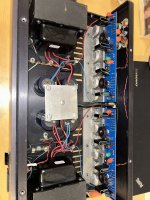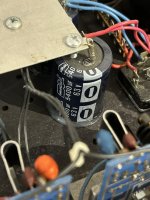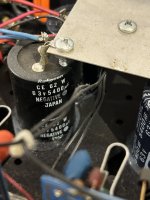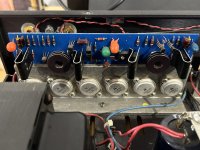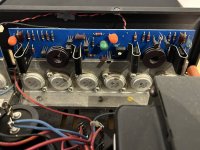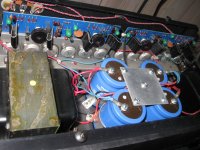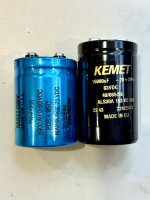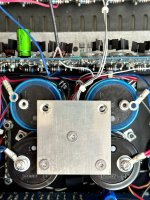Happy new years all!
I received this amplifier years ago as a gift and have been enjoying it with a pair of KEF LS50, until the left rca input failed…
Once I opened it up, it was apparent that there were some previous repairs done. There was a hand-written date code on the transformers (98’-99’) and the capacitors were not original (under-spec’d). Now I am on a mission to restore it.
I plan on replacing tantalums with electrolytics and new filter caps. I assumed the 5,400uf caps should be 15,000uf.
Would a Kemet ALS31A153KE063 work?(Digikey link) other suggestions?
Many thanks!
I received this amplifier years ago as a gift and have been enjoying it with a pair of KEF LS50, until the left rca input failed…
Once I opened it up, it was apparent that there were some previous repairs done. There was a hand-written date code on the transformers (98’-99’) and the capacitors were not original (under-spec’d). Now I am on a mission to restore it.
I plan on replacing tantalums with electrolytics and new filter caps. I assumed the 5,400uf caps should be 15,000uf.
Would a Kemet ALS31A153KE063 work?(Digikey link) other suggestions?
Many thanks!
Attachments
Last edited:
Buy them from Digikey and they come in a box of 96!
https://uk.rs-online.com/web/p/aluminium-capacitors/3819122
You will need supports;
https://uk.rs-online.com/web/p/capacitors-accessories/0543490
At least you will get the sound back as it was by replacing the glued on inferior capacitors.
Screws for the studs are M5 10mm long with spring washers.
I would leave the Tants in as they have a better specification than most electrolytics.
https://uk.rs-online.com/web/p/aluminium-capacitors/3819122
You will need supports;
https://uk.rs-online.com/web/p/capacitors-accessories/0543490
At least you will get the sound back as it was by replacing the glued on inferior capacitors.
Screws for the studs are M5 10mm long with spring washers.
I would leave the Tants in as they have a better specification than most electrolytics.
Attachments
The Kemet 15,000 uF caps are very good, but they may be taller than the original parts used in the CAS-1. The power supply caps in my CAS-2 were Mallory 9600 uF. Check to see how much height you have available. I was able to fit the Kemets in my CAS-2, and they improved the sound.
Attachments
https://uk.rs-online.com/web/p/capacitors-accessories/0543490
I would leave the Tants in as they have a better specification than most electrolytics.
Many thanks for your reply! Would you suggest replacing them for new ones or leave them?
Thanks for these reference shots!The Kemet 15,000 uF caps are very good, but they may be taller than the original parts used in the CAS-1. The power supply caps in my CAS-2 were Mallory 9600 uF. Check to see how much height you have available. I was able to fit the Kemets in my CAS-2, and they improved the sound.
It’s tight, but I should have 3-4mm left based on measurements.
Once you put in the new caps (filter and line), did you have to adjust any rails? I have a decent MM, but have not checked anything besides dc offset which is good (forget the measurements).
Many thanks!
Consider adding a sheet of Nomex paper, or another strong insulator, over the capacitors
to prevent their shorting to the top of the cover. It could be attached to the copper with nylon screws.
to prevent their shorting to the top of the cover. It could be attached to the copper with nylon screws.
I did not make (or need to) any rail adjustments. The larger value PSU caps simply do a better job of filtering the power from the rectifiers. This isn't the CRC that we are used to, just a big C. I placed Kapton tape on the underside of the lid where the big cap terminals are located, just in case.
I did make some careful capacitor replacements elsewhere on the channel boards. The main one was replacing the feedback AC coupling cap with a Nichicon ES series, the one in green. There were also two cascode voltage setting caps that I replaced with Mundorf Bidirectional RAW caps. The Threshold CAS-2 is a wonderful amp. I hope you get your CAS-1 restored to full health.
I did make some careful capacitor replacements elsewhere on the channel boards. The main one was replacing the feedback AC coupling cap with a Nichicon ES series, the one in green. There were also two cascode voltage setting caps that I replaced with Mundorf Bidirectional RAW caps. The Threshold CAS-2 is a wonderful amp. I hope you get your CAS-1 restored to full health.
Seems I did not factor in the studs and brackets in my measurements.
Seems like my options are:
1) Use risers for the case lid
2) Mount the 36x105 versions sideways
3) Find a lower profile option or go down in capacitance
Thoughts?
Seems like my options are:
1) Use risers for the case lid
2) Mount the 36x105 versions sideways
3) Find a lower profile option or go down in capacitance
Thoughts?
Depending on where those tantalums are used in the circuit I would either replace them with good low ESR electrolytics or my preference OSCON or similar polymer electrolytic. I have had tantalum fires in some older test equipment in the not terribly distant past.
Gave the case another measure… I originally thought the studs would take up too much space, but the ALS30 does give me just enough room to file down the screws to make it work.
After considering the +-1mm tolerance for cap length, this gives me 1.5-2mm of clearance which I can then lay multiple layers of Kapton or another insulating laminate (looking for now).
If this cutting it too close let me know, otherwise I think I will move a head with these parts 👍
After considering the +-1mm tolerance for cap length, this gives me 1.5-2mm of clearance which I can then lay multiple layers of Kapton or another insulating laminate (looking for now).
If this cutting it too close let me know, otherwise I think I will move a head with these parts 👍
If you do this, Kapton film is not good enough. Use tough material like Nomex or Garolite.
I did a similar thing to a Forte' amp that I have, and applied Nomex to the underside of the top cover. It has to be a durable insulation material.
Nomex is it! I’ll be looking to source some this week along with the components, many thanks for your help along the way!If you do this, Kapton film is not good enough. Use tough material like Nomex or Garolite.
Definitely going that way 👍I did a similar thing to a Forte' amp that I have, and applied Nomex to the underside of the top cover. It has to be a durable insulation material.
If you don't mind me asking, what thickness did you go for (type 410?) and what type of adhesive worked for you?
Many thanks!
Good questions, that's for sure. I cannot tell you thickness myself, but just would say it is robust. Card stock type paper thickness. The glue wasn't vey easy for some reason. As I recall, it might have been a rubber cement type. Not a great choice really for a couple of reasons. One, I don't know how well it does in a heated environment such as a Class A amp, and also the paper was tougher than the glue! Find something that is not such a chance in a heated environment, and of course something that has some beefiness to it. Often times, in electronics I see what appears to be a sort of hot melt type of adhesive.
Recently I have tried a product with some stupid name E6000. Anyway, it is similar to a silicone glue at first but seems to cure much faster, and turns rather rigid when dry. I would be tempted to try it.
Recently I have tried a product with some stupid name E6000. Anyway, it is similar to a silicone glue at first but seems to cure much faster, and turns rather rigid when dry. I would be tempted to try it.
- Home
- Amplifiers
- Pass Labs
- Threshold CAS 1 - Trying to undo a previous “repair”
